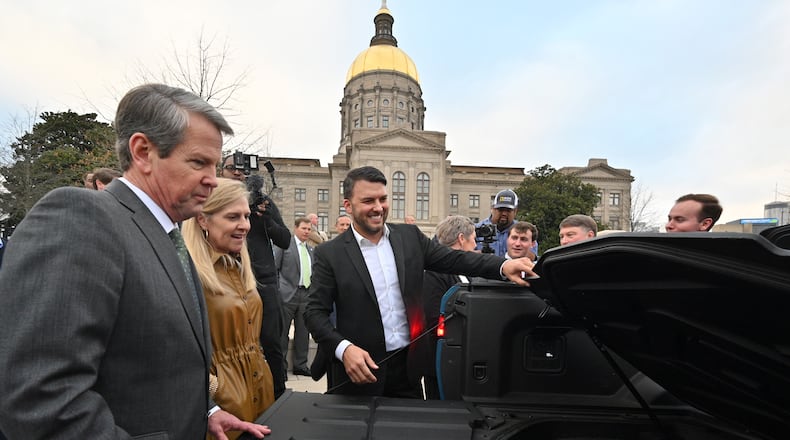In late October, Gov. Brian Kemp had just finished up a meeting in Columbus when he received an urgent call. The top executives of Rivian, the fast-growing electric vehicle manufacturer, were ready to tour the vast industrial land the state was pitching for a factory. And they wanted to come soon.
Early the morning of Oct. 20, Kemp helicoptered to the East Atlanta Mega Site for a 30-minute meeting with Rivian Chief Executive RJ Scaringe that would help seal the deal for a $5 billion plant that Kemp is calling the largest single economic development project in state history.
“I don’t think we were on their mind early on. All we were trying to do is get them to Georgia, to show them the site and sell them on what we’ve got,” he said in an interview. “We knew if we could get them here, we could make a good case. And that’s what happened.”
It was the tail end of a crusade to win the state’s first auto manufacturing facility since Kia planted roots in Georgia in 2006 — and the product of decades of groundwork by local leaders, business recruiters and political officials.
There are still many questions that remain about the sprawling site, including the political fallout of the deal and the bounty of incentives that it took to woo the project and the 7,500 jobs it promises to create.
But as the governor joined his wife Marty ahead of a celebratory press conference Thursday, he admitted he might be just as relieved as he was excited.
“I am just glad we got to the finish line,” he said.
A ‘jewel’ uncovered
The state’s pursuit of Rivian began more than a year ago, but the roots of the project go far deeper. A Joint Development Authority was created in the late 1990s to partner with private developers to create Stanton Springs, a successful bio-science research park where four counties meet about an hour’s drive east of Atlanta.
Encouraged by the venture, the authority joined with county leaders to assemble a pair of new mega-sites, including 2,000 acres north of Stanton Springs along I-20 where Rivian will locate its facility.
David Bernd, a former Newton County Chamber of Commerce executive, said the four county partners —Jasper, Morgan, Newton and Walton — dreamed of luring an automaker there, though they knew it wouldn’t be an easy sell.
But the region has I-20, major freight rail lines and is close to Atlanta.
“We’ve got all the components to knock it out of the park,” Bernd said.
Susan Holmes was mayor of the nearby town of Monticello during that time, and she helped convene regional meetings to plot strategy to win major projects.
“We were desperate for jobs and development in our community,” said Holmes, now a state legislator. “We called Jasper County the rural jewel, but we had not yet been discovered. We knew we had to join with other counties to promote ourselves.”
That effort picked up six years ago, when local economic development officials arranged a half-dozen tours of the Kia factory in West Point with community leaders.
Randy Jackson, who was then Kia’s top executive in Georgia, told the group they needed to improve schools and training to win a plant. One of Bernd’s takeaways from the tours: Local graduation rates and training offered at a nearby technical college wouldn’t cut it.
Credit: HYOSUB SHIN / AJC
Credit: HYOSUB SHIN / AJC
New investments in education helped boost the area’s graduation rates, and the state financed an advanced manufacturing facility at Georgia Piedmont Technical College.
At the same time, local officials began assembling ever-larger tracts of land big enough to accommodate a massive plant. The land was pitched to a joint venture by Toyota-Mazda, which went to Alabama, and Volvo, which spurned Georgia to build instead in South Carolina. More recently, it was also a finalist for a Tesla facility that was awarded to Texas.
Then Rivian came calling.
“I think all those payoffs over the last eight or nine years have gotten us over the hump,” Bernd said.
‘Fast as hell’
The Atlanta Journal-Constitution reported in July that Georgia was courting the company. Attention at the time was on another state mega-site along I-16 near Savannah, even as state officials also pitched sites in the Atlanta area. East Atlanta Megasite’s proximity to Atlanta and its rich talent pool appears to have outweighed the I-16 site’s access to the Savannah and Brunswick seaports.
When Kemp was informed that Rivian was scouting the site near Social Circle over the summer, he didn’t need a primer on the emerging tech company. He had read plenty about the Wall Street darling that’s seen by many as a top rival to Tesla.
Rivian was looking to build a second factory to complement its plant in Illinois, and the automaker was scouting Arizona, Texas and other states for the multibillion-dollar investment.
And Pat Wilson, the state’s top economic development recruiter, persuaded the firm’s leaders to fly to Georgia on Aug. 24. Kemp wanted to meet them personally when they arrived.
Credit: HYOSUB SHIN / AJC
Credit: HYOSUB SHIN / AJC
After some small talk at a Midtown office, the governor launched into a pitch focused on Georgia’s well-regarded workforce training programs and the mega-site’s location near rail lines, I-20 and about 50 miles from Atlanta’s airport.
“They weren’t worried about glamour and show,” he said of Rivian executives. “They wanted to talk business.”
He also cited the state’s broader push to lure EV companies as the automotive sector shifts away from gas vehicles. A new statewide initiative Kemp launched promised to tackle supply chain issues in the nascent industry, and he pointed to the massive SK Innovation battery-making plant under construction in northeast Georgia.
The negotiations continued from there, as Georgia readied plans for an on-site workforce training facility and an incentive package that Wilson said largely mirrors the bounty of perks offered to Kia, which totaled more than $400 million.
Then came the October call that Rivian’s top executives were ready to take the next step and tour the site. When Kemp arrived by helicopter at the site the next morning, he was greeted by Scaringe — and one of the high-powered electric trucks the company makes.
The governor took a ride with Scaringe and then got behind the wheel. His initial impression: “That damn truck is fast as hell.”
After they took a spin, the two got down to business.
“It’s not like this is the first deal where we competed with Texas,” he said. “We’ve got jobs tax credits in the statutes, other tools at our disposal. But what I focused on was speed to market and the workforce that we could help train. Those were the biggest selling points.”
Shane Short, executive director of the joint development authority, said after the meeting with Kemp ended, Scaringe and the Rivian team stayed on the site for hours and discussed ways to minimize the factory’s environmental impact.
“He wasn’t the kind of guy where you sit across a table with attorneys and they grill you,” Short said of Scaringe. “He’s personable and we had a casual conversation the entire time. He wanted to know about the community.”
It took weeks of negotiations after that meeting to finalize the deal. All the while, the local economic development agency continued to approach local property owners to offer to buy their land near the site, according to five people who spoke to the AJC.
A key part of the site belongs to the family of Alan Verner, a former chairman of the authority.
And state transportation officials drafted potential plans to add lanes to surrounding roads and a new interchange on I-20 to serve the new factory.
Kemp said when Rivian’s agreement was substantially completed a few weeks ago, he felt a wave of relief.
“You were very excited, too,” his wife Marty added.
“I was,” Kemp said. “These are generational, transformational projects.”
Keep Reading
The Latest
Featured








